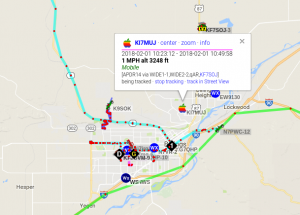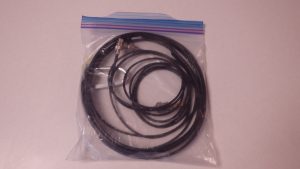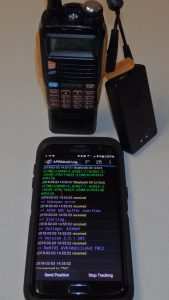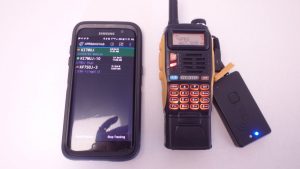Backpacking with APRS
Automatic Packet Reporting System (APRS) was developed in 1992 with the purpose of giving ham radio operators a way to transmit their location, allowing them to view the locations of other ham users, and send messages to each other. APRS is a mature technology, which is widely implemented in the ham community. Odds are good that there is a digipeater within range of your home. For backpackers, APRS presents an easy way to keep in touch with loved ones, while camping and hiking in the wilderness. Although APRS might sound like a hard system to operate, modern enhancements have made communicating via APRS an easy solution.
In order to backpack while using APRS, there are a few considerations that should be made. First, your handheld radio must be as powerful as possible, while still maintaining sound quality. Second, you will need a better antenna than the one supplied with your radio. Finally, you must find an interface between your analog radio, and an APRS digipeater or igate (systems that relay your transmissions to other radios, or the Internet). With all of these pieces combined, the most important choice is your handheld transceiver.
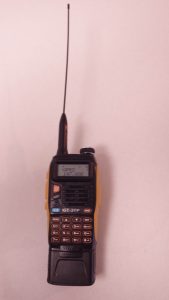
My BaoFeng GT-3
Not all radios are alike. Output power, turn around time (the time it takes for a radio to switch between sending and receiving, or vice-versa), and ruggedness are just a few of the considerations to keep in mind when buying a handheld radio. For power, 8 watts is ideal, with 5 watts being more common. For turn around time, avoid the UV-5R series by BaoFeng– many ham users have reported issues with using this radio with a closed squelch. For durability, look for a radio that is water resistant, or better yet waterproof. The BaoFeng GT-3 or BaoFeng BF-F8HP are excellent choices. BaoFeng has dominated the handheld radio market with lower cost quality radios; it’s impossible to find a better radio on the market for BaoFeng’s low price of $50. Now that you’ve purchased a radio, you’ll need to find a better antenna than the one that shipped with your radio.
For antennas, bigger is usually always better. This applies to your handheld just as it applies to a larger station. For mobile use, a high-gain antenna that is easy to transport and deploy is desirable. One such antenna is made by Dr. Ed Fong, the DJB-2. The DJB-2 rolls up easily, and will fit in a pocket in your backpack. Dr. Fong’s DJB-2 is build by university students studying Wireless Communications at the University of California- Santa Cruz, with each antenna being hand tuned by Dr. Fong himself. Whether or not if you choose to purchase the DJB-2, purchase an antenna like it– portable, easy to setup, and reliable. Once you have your radio and your antenna, you can start investigating the many options available for making an analog radio ready for packet systems like APRS.
APRS is a digital service that uses the 144.390 frequency. In order to set this up on your analog radio you will need a TNC, or Terminal Node Controller. A popular and outstanding choice for a TNC would be the Mobilinkd TNC. This TNC is compatible with an Android-based phone (Apple owners can always purchase a cheap Android-based phone off of Amazon, like the LG Rebel, which will run the required software (APRSdroid). APRSdroid interfaces with the Mobilinkd TNC to offer you a user interface to the APRS network. You can view other users in your area, send messages, and send your GPS coordinates to the APRS network. We’re interested in the last two options– sending your GPS coordinates, and sending messages using APRS.
You might be thinking– what’s the point of sending a message via APRS system? I don’t know of any other hams that could help me out in the middle of the night, or during an emergency. This is where EMAIL-2, an email gateway, comes into play. If you send a message to EMAIL-2 with an email address, followed by a message, EMAIL-2 will happily send that email. The beauty of this is that most cell phones do in fact have an email address associated with them. Verizon users have an email address set to 5555555555@vtext.com, where 5555555555 is their cell phone number. This is then converted to a text message, and then sent through Verizon’s network to your emergency contact’s cell phone. With APRS, you’re not only able to send text messages/emails to your family, they can also view your exact location.
The default setting on APRSdroid is to report your exact location. From the moment you tap “Start Tracking”, your radio is hopefully transmitting your GPS coordinates to a digipeater or igate, where it is then posting your coordinates for the world to see. This might seem like a privacy issue, but out in the wilderness, it’s a good idea. This allows your family to track your location as you move along your backpacking trip, and it also allows search and rescue to pinpoint your location. All of this information can be viewed at https://aprs.fi.
APRS is a useful service that is free for ham radio operators, and it is maturing daily. New digipeaters and igates are installed on a daily basis, and new hams typically start with APRS as their first packet protocol. That being said, sometimes you might be out of reception. Moving uphill or hiking to a mountaintop may solve this issue, or it may not. Depending on where you are backpacking, you might want to invest some more time and money to get reliable APRS reception. In my next article, I will discuss Digipeating While Backpacking— the ultimate solution for your APRS reception woes.
